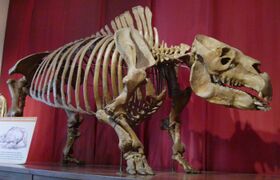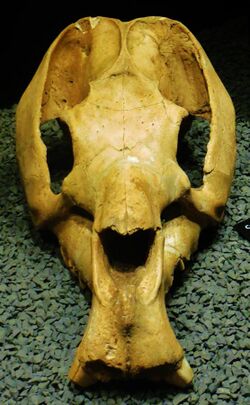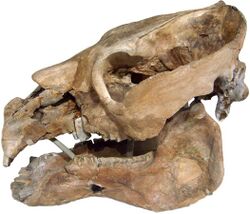Biology:Toxodon
| Toxodon | |
|---|---|

| |
| Skeleton of Toxodon in Buenos Aires | |
| Scientific classification | |
| Domain: | Eukaryota |
| Kingdom: | Animalia |
| Phylum: | Chordata |
| Class: | Mammalia |
| Order: | †Notoungulata |
| Family: | †Toxodontidae |
| Subfamily: | †Toxodontinae |
| Genus: | †Toxodon Owen, 1837 |
| Type species | |
| †Toxodon platensis Owen, 1837
| |
| Other species | |
| |
| Synonyms | |
|
Genus-level
T. platensis
T. burmeisteri
T. chapalmalensis
T. ensenadensis
T. gracilis
| |
Toxodon (meaning "bow tooth" in reference to the curvature of the teeth) is an extinct genus of large ungulate native to South America from the Late Miocene to early Holocene epochs (Mayoan to Lujanian in the SALMA classification) (about 11.6 million to 11,000 years ago).[1][2] Toxodon was one of the last surviving members of Notoungulata, an order of extinct South American native ungulates distinct from living ungulate groups that had been indigenous to the continent since the Paleocene.[3] Toxodon is a member of the family Toxodontidae, which includes medium to large sized herbivores.[4] Toxodon was one of the largest members of Toxodontidae and Notoungulata, with Toxodon platensis having an estimated body mass of 1,000–1,200 kilograms (2,200–2,600 lb).[5]
Toxodon has been found across much of South America, excluding southern Patagonia, the Andes and northeastern-most region of the continent.[6] Evidence suggests that Toxodon was ecologically plastic able to adapt its diet to local conditions.[7]
Toxodon became extinct as part of the end-Pleistocene extinctions around 12,000 years ago, along with most large mammals across the Americas.[3]
Taxonomy
Toxodon was one of the last members of Notoungulata, a group of ungulates that had been part of the fauna of South America since the Paleocene. Toxodon was a member of Toxodontidae a large bodied group including similar, vaguely rhinoceros like forms.
Charles Darwin was one of the first to collect Toxodon fossils, after paying 18 pence for a T. platensis skull from a farmer in Uruguay.[8] In The Voyage of the Beagle Darwin wrote, "November 26th – I set out on my return in a direct line for Montevideo. Having heard of some giant's bones at a neighbouring farm-house on the Sarandis, a small stream entering the Rio Negro, I rode there accompanied by my host, and purchased for the value of eighteen pence the head of the Toxodon."[9] Since Darwin discovered that the fossils of similar mammals of South America were different from those in Europe, he invoked many debates about the evolution and natural selection of animals.
In his own words, Darwin wrote down in his journal,
Lastly, the Toxodon, perhaps one of the strangest animals ever discovered: In size it equaled an elephant or megatherium, but the structure of its teeth, as Mr. Owen states, proves indisputably that it was intimately related to the Gnawers, the order which, at the present day, includes most of the smallest quadrupeds: In many details it is allied to the Pachydermata: Judging from the position of its eyes, ears, and nostrils, it was probably aquatic, like the Dugong and Manatee, to which it is also allied. How wonderfully are the different Orders, at the present time so well separated, blended together in different points of the structure of the Toxodon!
Analysis of collagen sequences obtained from Toxodon as well as from Macrauchenia found that South America's native notoungulates and litopterns form a sister group to perissodactyls, making them true ungulates.[10][11] This finding has been corroborated by an analysis of mitochondrial DNA extracted from a Macrauchenia fossil, which yielded a date of 66 Ma for the time of the split with perissodactyls.[12]
Evolution
The species Toxodon chapalmalensis is known from the Pliocene (Montehermosan-Chapadmalalan) of Argentina,[13] while Toxodon platensis, the type species, is known from the Pleistocene.
In 2014, a study identifying a new species of toxodontid resolved the phylogenetic relations of the toxodontids, including to Toxodon. The below cladogram was found by the study:[14]
| †Notoungulata |
| ||||||||||||||||||||||||||||||||||||||||||||||||||||||||||||||||||||||||||||||||||||||||||||||||||||||||||||||||||||||||||||||||||||||||||||||||
Description

Toxodon was about 2.7 m (8 ft 10 in) in body length, with an estimated weight up to 1,415 kg (3,120 lb)[15] and about 1.5 m (4 ft 11 in) high at the shoulder and resembled a heavy rhinoceros, with a short and vaguely hippopotamus-like head.[16] Because of the position of its nasal openings, it is believed that Toxodon had a well-developed snout.[citation needed] Toxodon possessed a large, barrel shaped body. It had short stout legs with plantigrade feet with three functional relatively short toes. The hind limbs are longer and raised higher than the front limbs, giving a sloped appearance to the body.[17] Like horses, it had a stay apparatus allowing the knees to be passively locked while standing.[18]
The vertebrae were equipped with high apophyses, which most likely supported the massive weight and muscles as well as its powerful head.[citation needed] Toxodon had broad jaws which were filled with bow shaped teeth and incisors.[3] The molar teeth of Toxodon have no roots and are ever-growing (euhypsodont), like the incisors of rodents and lagomorphs, and often exhibit enamel hypoplasia.[19]
Palaeobiology

Toxodon is suggested to have been capable of running at considerable speed.[20] Toxodon is believed to have been ecologically plastic and have had a wide niche breadth,[7] with its diet varying according to local conditions,[21] with an almost totally C3 browsing diet in the Amazon rainforest, mixed feeding C3 in Bahia and the Pampas to almost completely C4 dominated grazing diet in the Chaco.[22]
Extinction
Toxodon became extinct at the end of the Late Pleistocene around 12,000 years as part of the Quaternary extinction event, alongside almost all other large animals in South America. Previous mid-Holocene dates are now thought to be in error.[23] Remains from the Arroyo Seco 2 site in the Pampas are associated with butchered megafauna, but it is unclear if the Toxodon itself was actually butchered or the remains were naturally transported to the site.[24]


Distribution
Toxodon had a wide distribution in South America during the Late Pleistocene, extending from the Pampas into the Amazon rainforest.
Fossils of Toxodon have been found in:[2][25]
- Holocene
- Abismo Ponto de Flecha, Brazil
- Pleistocene
- San José, Fortin Tres Pozos, Chaco and Luján Formations, Argentina
- Tarija and Ñuapua Formations, Bolivia
- Brazil
- Paraguay
- Sopas and Dolores Formations, Uruguay
- Miocene-Pliocene (Montehermosan)
- Monte Hermoso Formation, Argentina
- Miocene
- Ituzaingó Formation, then described as Entrerriana Formation, Argentina
References
- ↑ "ESR dating of a toxodon tooth from a Brazilian karstic cave". Applied Radiation and Isotopes 52 (5): 1345–9. May 2000. doi:10.1016/S0969-8043(00)00093-2. PMID 10836452. Bibcode: 2000AppRI..52.1345B.
- ↑ 2.0 2.1 Turvey, Samuel T. (2009-05-28). Holocene Extinctions. OUP Oxford. ISBN 978-0-19-157998-1. https://books.google.com/books?id=mbU-F42JU1AC&q=Propaopus&pg=PA349.
- ↑ 3.0 3.1 3.2 Croft, Darin A.; Gelfo, Javier N.; López, Guillermo M. (30 May 2020). "Splendid Innovation: The Extinct South American Native Ungulates" (in en). Annual Review of Earth and Planetary Sciences 48 (1): 259–290. doi:10.1146/annurev-earth-072619-060126. ISSN 0084-6597. Bibcode: 2020AREPS..48..259C. https://www.annualreviews.org/doi/10.1146/annurev-earth-072619-060126. Retrieved 2 January 2024.
- ↑ Cassini, Guillermo H.; Flores, David A.; Vizcaíno, Sergio F. (July 2012). "Postnatal ontogenetic scaling of Nesodontine (Notoungulata, Toxodontidae) cranial morphology: Nesodontine cranial allometry" (in en). Acta Zoologica 93 (3): 249–259. doi:10.1111/j.1463-6395.2011.00501.x. https://onlinelibrary.wiley.com/doi/10.1111/j.1463-6395.2011.00501.x.
- ↑ Nelson, Allison; Engelman, Russell K.; Croft, Darin A. (2023-07-12). "How to weigh a fossil mammal? South American notoungulates as a case study for estimating body mass in extinct clades" (in en). Journal of Mammalian Evolution. doi:10.1007/s10914-023-09669-1. ISSN 1064-7554. https://link.springer.com/10.1007/s10914-023-09669-1.
- ↑ Cione, Alberto Luis; Gasparini, Germán Mariano; Soibelzon, Esteban; Soibelzon, Leopoldo Héctor; Tonni, Eduardo Pedro (2015), "The GABI in Southern South America" (in en), The Great American Biotic Interchange (Dordrecht: Springer Netherlands): pp. 71–96, doi:10.1007/978-94-017-9792-4_3, ISBN 978-94-017-9791-7, https://link.springer.com/10.1007/978-94-017-9792-4_3, retrieved 2024-01-30
- ↑ 7.0 7.1 Dantas, Mário André Trindade; Cherkinsky, Alexander; Bocherens, Hervé; Drefahl, Morgana; Bernardes, Camila; França, Lucas de Melo (15 August 2017). "Isotopic paleoecology of the Pleistocene megamammals from the Brazilian Intertropical Region: Feeding ecology (δ13C), niche breadth and overlap". Quaternary Science Reviews 170: 152–163. doi:10.1016/j.quascirev.2017.06.030. ISSN 0277-3791. https://www.sciencedirect.com/science/article/pii/S0277379117300616. Retrieved 2 January 2024.
- ↑ Quammen, D. (February 2009). "Darwin's first clues". National Geographic: 45.
- ↑ Darwin, Charles (1997). Browne, J.; Neve, M.. eds. The Voyage of the Beagle. ISBN 978-0-14-043268-8. "Read, 19th April 1837. A detailed account will appear in the first part of the zoology of Voyage of the Beagle."
- ↑ "Ancient proteins resolve the evolutionary history of Darwin's South American ungulates". Nature 522 (7554): 81–4. June 2015. doi:10.1038/nature14249. PMID 25799987. Bibcode: 2015Natur.522...81W. http://eprints.whiterose.ac.uk/91438/1/Welker_postprint.docx.
- ↑ Buckley, M. (7 May 2015). "Ancient collagen reveals evolutionary history of the endemic South American 'ungulates'". Proceedings of the Royal Society B: Biological Sciences 282 (1806): 20142671. doi:10.1098/rspb.2014.2671. PMID 25833851.
- ↑ "A mitogenomic timetree for Darwin's enigmatic South American mammal Macrauchenia patachonica". Nature Communications 8: 15951. June 2017. doi:10.1038/ncomms15951. PMID 28654082. Bibcode: 2017NatCo...815951W.
- ↑ Tomassini, Rodrigo L.; Montalvo, Claudia I.; Deschamps, Cecilia M.; Manera, Teresa (December 2013). "Biostratigraphy and biochronology of the Monte Hermoso Formation (early Pliocene) at its type locality, Buenos Aires Province, Argentina". Journal of South American Earth Sciences 48: 31–42. doi:10.1016/j.jsames.2013.08.002. ISSN 0895-9811. Bibcode: 2013JSAES..48...31T. http://dx.doi.org/10.1016/j.jsames.2013.08.002. Retrieved 2 January 2024.
- ↑ "New toxodontid (Notoungulata) from the Early Miocene of Mendoza, Argentina". Paläontologische Zeitschrift 89 (3): 611–634. 2014. doi:10.1007/s12542-014-0233-5. http://sedici.unlp.edu.ar/handle/10915/127531.
- ↑ "Splendid oddness: revisiting the curious trophic relationships of South American Pleistocene mammals and their abundance". Anais da Academia Brasileira de Ciências 86 (1): 311–31. March 2014. doi:10.1590/0001-3765201420120010. PMID 24676170.
- ↑ Fariña, Richard A.; Vizcaíno, Sergio F.; de Iuliis, Gerry (2012). Megafauna: Giant Beasts of Pleistocene South America.. Indiana University Press. ISBN 978-0-253-00230-3.
- ↑ Defler, Thomas (2019), "The Native Ungulates of South America (Condylarthra and Meridiungulata)", History of Terrestrial Mammals in South America, Topics in Geobiology (Cham: Springer International Publishing) 42: pp. 102, doi:10.1007/978-3-319-98449-0_5, ISBN 978-3-319-98448-3, http://link.springer.com/10.1007/978-3-319-98449-0_5, retrieved 2020-07-10
- ↑ Shockey BJ. 2001. "Specialized knee joints in some extinct, endemic, South American herbivores" Acta Palaeontologica Polonica 46:277–88
- ↑ Braunn, Patrícia R.; Ribeiro, Ana M.; Ferigolo, Jorge (July 2014). "Microstructural defects and enamel hypoplasia in teeth of Toxodon Owen, 1837 from the Pleistocene of Southern Brazil" (in en). Lethaia 47 (3): 418–431. doi:10.1111/let.12063. Bibcode: 2014Letha..47..418B. http://doi.wiley.com/10.1111/let.12063.
- ↑ S.F. Vizcaino, R.A. Farina, J.C. Fernicola "Young Darwin and the ecology and extinction of Pleistocene South American fossil mammals" Revista de la Asociacion Geologica Argentina, 64 (2009), pp. 160-169
- ↑ Pansani, Thaís Rabito; Muniz, Fellipe Pereira; Cherkinsky, Alexander; Pacheco, Mírian Liza Alves Forancelli; Dantas, Mário André Trindade (October 2019). "Isotopic paleoecology (δ13C, δ18O) of Late Quaternary megafauna from Mato Grosso do Sul and Bahia States, Brazil" (in en). Quaternary Science Reviews 221: 105864. doi:10.1016/j.quascirev.2019.105864. Bibcode: 2019QSRv..22105864P. https://linkinghub.elsevier.com/retrieve/pii/S0277379119302926.
- ↑ MacFadden, Bruce J. (September 2005). "Diet and habitat of toxodont megaherbivores (Mammalia, Notoungulata) from the late Quaternary of South and Central America" (in en). Quaternary Research 64 (2): 113–124. doi:10.1016/j.yqres.2005.05.003. Bibcode: 2005QuRes..64..113M. http://linkinghub.elsevier.com/retrieve/pii/S0033589405000712. Retrieved 2 January 2024.
- ↑ "Campo Laborde: A Late Pleistocene giant ground sloth kill and butchering site in the Pampas". Science Advances 5 (3): eaau4546. March 2019. doi:10.1126/sciadv.aau4546. PMID 30854426. Bibcode: 2019SciA....5.4546P.
- ↑ "The Arrival of Homo sapiens into the Southern Cone at 14,000 Years Ago". PLOS ONE 11 (9): e0162870. 28 September 2016. doi:10.1371/journal.pone.0162870. PMID 27683248. Bibcode: 2016PLoSO..1162870P.
- ↑ Toxodon at Fossilworks.org
Further reading
- Cox, Barry; Harrison, Colin; Savage, R.J.G.; Gardiner, Brian (October 1999). The Simon & Schuster Encyclopedia of Dinosaurs and Prehistoric Creatures: A Visual Who's Who of Prehistoric Life. Simon & Schuster. ISBN 978-0-684-86411-2. https://archive.org/details/simonschusterenc00coxb.
Wikidata ☰ Q131467 entry
 |

